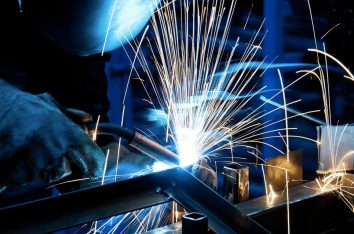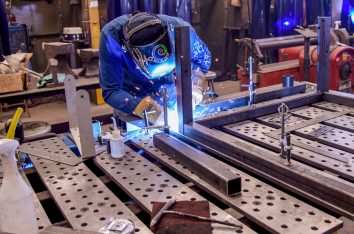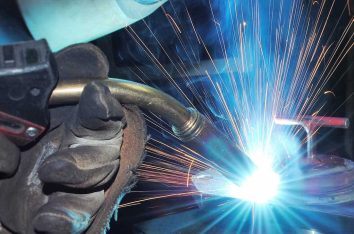The manufacturing world is changing fast, thanks to new technology. One of the biggest game-changers is CNC (Computer Numerical Control) machining. This tech is making factories more precise, efficient, and versatile. CNC machining is not only improving what industries can do but also pushing the limits of what's possible. This article dives into how CNC machining is reshaping manufacturing.
Key Takeaways
- CNC machining is revolutionizing manufacturing by enhancing precision and efficiency.
- The technology has evolved from simple automation to a cornerstone of modern manufacturing.
- High-speed machining and multi-axis capabilities are among the latest advancements.
- CNC machining is crucial in industries like aerospace, automotive, and medical devices.
- Future trends include AI integration, sustainability, and on-demand production.
The Historical Development of CNC Machining
CNC (Computer Numerical Control) machining has revolutionized the manufacturing industry, evolving from early numerical control (NC) systems in the 1940s to the advanced, computer-controlled machines of today. This section will explore the key milestones and advancements that have shaped the history of CNC machining, paving the way for its widespread adoption and impact on modern manufacturing.
Early Innovations and Milestones
The origins of CNC machining can be traced back to the 1940s when John T. Parsons and Frank L. Stulen developed the first numerical control system for machining aircraft parts. This marked the beginning of a technological revolution that would forever change the face of manufacturing. After years of effort, engineers produced the first CNC machine. The first milling machine provided decent control through computers and automated production.
Transition to Digital Control
As technology advanced, the transition from analog to digital control systems became inevitable. This shift allowed for greater precision and flexibility in manufacturing processes. The introduction of microprocessors in the 1970s further enhanced the capabilities of CNC machines, making them more efficient and easier to program.
Modern-Day CNC Systems
Today's CNC systems are a far cry from their early predecessors. Modern machines are equipped with advanced software and hardware that enable them to execute complex designs with high accuracy. They are now integral to various industries, from aerospace to medical device manufacturing, offering custom solutions that meet stringent quality standards.
Core Principles of CNC Machining
CNC Machining is built on the transformation of digital designs into precise, physical components. This process is governed by Computer Numerical Control, which directs the movement of machinery and tools with unmatched accuracy. The term "CNC" encapsulates a digital orchestration of traditional manufacturing processes.
Understanding Computer Numerical Control
At its core, CNC Machining operates by converting digital blueprints into tangible parts through the careful removal of material. This method allows for the creation of components with high precision, meeting the exact specifications of the design.
Key Components of CNC Machines
CNC machines consist of several essential parts:
- Controller: The brain of the machine, interpreting the digital design and sending commands to the machinery.
- Machine Tool: The physical device that performs the cutting, drilling, or milling.
- Drive System: Powers the movement of the machine tool.
- Feedback System: Ensures the machine follows the correct path and makes adjustments as needed.
Basic Operations and Techniques
CNC Machining encompasses various processes such as milling, turning, drilling, and grinding. Each technique offers a unique way to achieve the desired component, tailored to its specific requirements. This versatility not only streamlines production but also fosters innovation in material science and engineering design.
Technological Advancements in CNC Machining
Technological advancements in CNC machining have revolutionized the manufacturing landscape. These innovations have not only enhanced the capabilities of manufacturers but also opened doors to new possibilities in product design and creation.
High-Speed Machining
High-speed machining is characterized by its ability to operate at unprecedented speeds while maintaining accuracy. This technique allows for the production of lighter, stronger, and more durable components, especially in industries such as aerospace and automotive. However, challenges such as heat generation, tool wear, and dynamic forces must be managed to fully leverage this technology.
Multi-Axis Capabilities
The introduction of multi-axis CNC machines has redefined precision in manufacturing. These machines can move tools along multiple axes simultaneously, enabling the creation of complex geometries that were previously impossible. This capability is particularly beneficial in the production of intricate components for the aerospace, automotive, and medical device industries.
Integration with AI and Machine Learning
The integration of AI and machine learning into CNC machining systems is paving the way for smarter manufacturing processes. These technologies enable predictive maintenance, optimize tool paths, and improve overall efficiency. As a result, manufacturers can achieve higher levels of accuracy and consistency, further reducing production time and costs.
Impact of CNC Machining on Manufacturing Efficiency
CNC machining has revolutionized manufacturing by significantly boosting efficiency. Automating tasks that were once manual allows manufacturers to produce more parts in less time, maintaining consistent quality. This not only cuts production costs but also helps manufacturers respond to market demands faster.
CNC machining is known for its precision, which reduces waste material through exact cutting. This efficiency is both environmentally friendly and cost-effective, as it lowers raw material costs. Additionally, automation minimizes labor costs and human error, further reducing production expenses.
Improved operational efficiency through CNC machining results in shorter production times and higher quality products. Process optimization decreases energy use and minimizes waste, aligning with stricter sustainability standards.
Applications of CNC Machining in Various Industries
CNC machining is a versatile technology that has found applications in numerous industries. Its ability to work with a wide range of materials, from metals to plastics, makes it invaluable in sectors that demand precision and efficiency. Below, we explore how CNC machining is utilized in three key industries: aerospace and defense, automotive, and medical device manufacturing.
Aerospace and Defense
In the aerospace and defense sectors, CNC machining is crucial for producing high-precision components. These industries require parts that meet stringent safety and performance standards. CNC machines are used to manufacture complex parts for aircraft, spacecraft, and military equipment, ensuring unmatched accuracy and reliability.
Automotive Industry
CNC machining is revolutionizing the automotive industry by enabling the efficient production of vehicle parts. It can be used to create several important components of a car's combustion engine, lights, suspension components, and exhaust parts. The technology allows for the mass production of these parts with high precision, reducing production time and costs.
Medical Device Manufacturing
In the medical field, CNC machining is essential for creating intricate and precise components used in medical devices. From surgical instruments to prosthetic limbs, CNC machines ensure that each part meets the exact specifications required for medical applications. This precision is vital for patient safety and the effectiveness of medical treatments.
Future Trends in CNC Machining
As CNC machining evolves, future trajectories go beyond just speed. The focus lies in integrating sustainability, adaptability, and scalability into high-speed production processes. Additionally, advancements in hybrid manufacturing, additive-subtractive techniques, and process optimization will shape the CNC landscape.
Emerging Technologies
The future of CNC machining includes cutting-edge developments in materials and hybrid manufacturing. These innovations will drive efficiency, customization, and sustainability in manufacturing operations. Embracing these advancements is not just an opportunity but a necessity for businesses looking to thrive in the rapidly evolving global marketplace.
Sustainability and Green Manufacturing
Sustainability is becoming a key focus in CNC machining. Future systems will prioritize energy efficiency, waste reduction, and the use of eco-friendly materials. This shift towards green manufacturing is essential for meeting environmental regulations and consumer demands for sustainable products.
Customization and On-Demand Production
The ability to produce customized and on-demand products will be a significant trend in CNC machining. This flexibility allows manufacturers to meet specific customer needs quickly and efficiently, enhancing overall market competitiveness. Customization and rapid production capabilities will be crucial for businesses aiming to stay ahead in the market.
Challenges and Solutions in CNC Machining
While CNC machining offers numerous benefits, it also presents unique challenges that manufacturers must overcome. This section will delve into the common challenges faced in CNC machining, such as tool wear, vibration, and precision, and discuss the innovative solutions and best practices that have been developed to address these issues, ensuring the continued success and advancement of CNC machining.
Overcoming Technical Limitations
CNC machining faces several technical hurdles, such as heat generation, tool wear, and dynamic forces. Next-gen CNC machines tackle these issues with innovative cooling systems, advanced tool materials, and predictive maintenance strategies. These solutions ensure machines operate at peak performance.
Workforce Training and Skill Development
The rapid evolution of CNC technology demands continuous workforce training. Operators must stay updated with the latest advancements to maintain efficiency and safety. Training programs and certifications are essential to equip workers with the necessary skills.
Ensuring Cybersecurity
In this section, we address the key challenges and considerations that are shaping the future of CNC machining: cybersecurity concerns. The integration of CNC systems with digital networks exposes them to potential cyber threats. Implementing robust cybersecurity measures is crucial to protect sensitive data and maintain operational integrity.
The Role of CNC Machining in Industry 4.0
Industry 4.0, also known as the Fourth Industrial Revolution, is characterized by the integration of advanced technologies, such as the Internet of Things (IoT), artificial intelligence, and automation, into manufacturing processes. This section will explore how CNC machining is playing a crucial role in the Industry 4.0 landscape, enabling increased efficiency, flexibility, and data-driven decision making in manufacturing.
Smart Manufacturing
Industry 4.0 redefines our processes, with CNC machining as the essential cornerstone of this evolution. By strategically implementing CNC machining in this environment, we have achieved a synergy that goes beyond operational efficiency; it is a cultural shift toward constant innovation and adaptability.
Internet of Things (IoT) Integration
At the heart of the CNC machining revolution in Industry 4.0, industrial pumps emerge as key players in the optimization and efficiency of processes. These devices, essential for the precise supply of coolant and lubricants in high-tech machining environments, have become the pulsating soul of modern CNC machinery. System interconnection, real-time monitoring, and automatic adjustment capabilities are essential features driven by digitization, enabling smarter and more effective management of resources.
Data-Driven Decision Making
The future of CNC machining holds immense potential for revolutionizing the manufacturing industry and shaping the next industrial revolution. By embracing innovation, leveraging advanced technologies, and prioritizing skills development, manufacturers can stay ahead in the competitive landscape and drive continuous improvement in production processes. As Industry 4.0 unfolds, CNC machining will continue to be at the forefront of technological advancements, driving efficiency, customization, and innovation.
Case Studies: Success Stories in CNC Machining
o illustrate the real-world impact of CNC machining, this section will present several case studies highlighting successful applications of CNC technology in various industries. These case studies will showcase how companies have leveraged CNC machining to improve product quality, reduce costs, increase production speed, and gain a competitive edge in their respective markets.
Innovative Projects and Prototypes
In the world of CNC machining, innovation is key. One notable example is a motorcycle accessories manufacturer that increased automated production of prismatic components. This shift not only boosted efficiency but also set a new standard in the industry. Another case involves a valve manufacturer that automated prismatic machining to cope with rising demand, showcasing the adaptability of CNC technology.
Efficiency Improvements
CNC machining has led to significant efficiency improvements across various sectors. For instance, in the aerospace industry, the adoption of CNC technology has streamlined the production of complex parts, reducing both time and costs. Similarly, in the medical device manufacturing sector, CNC machining has enabled the production of highly precise components, pushing the boundaries of what is possible.
Scalability and Mass Production
The scalability of CNC machining is another success story. Companies have leveraged this technology to transition from small-batch production to mass production seamlessly. This capability is particularly evident in the automotive industry, where CNC machining has facilitated the efficient production of high-quality parts on a large scale.
Comparing CNC Machining with Traditional Manufacturing Methods
While CNC machining has become a dominant force in modern manufacturing, traditional manufacturing methods still have their place. This section will compare and contrast CNC machining with traditional methods, such as manual machining and casting, highlighting the advantages and disadvantages of each approach. This comparison will help readers understand the unique strengths of CNC machining and when it is most appropriate to utilize this technology.
Differences in Precision and Accuracy
In the world of manufacturing, the precision of components can dictate the success or failure of entire systems. CNC machining stands out due to its unparalleled precision and efficiency. By using computer-controlled tools to produce intricate components, manufacturers can achieve higher levels of accuracy and consistency compared to traditional methods. This not only reduces the margin of error but also enhances overall productivity and quality control.
Speed and Efficiency Comparisons
The manufacturing landscape is undergoing a significant transformation, driven by the relentless pursuit of precision, efficiency, and versatility. CNC machining is generally faster than traditional methods for producing complex parts. The ability to perform multiple cuts in a single setup significantly reduces production time. Mill-turn machining is generally faster than traditional methods for producing complex parts.
Cost-Benefit Analysis
CNC machining services are not just enhancing the capabilities of industries but redefining the boundaries of what’s possible in manufacturing. While the initial investment in CNC machinery can be high, the long-term benefits often outweigh the costs. These benefits include reduced labor costs, lower material waste, and increased production speed. In contrast, traditional methods may have lower upfront costs but often result in higher long-term expenses due to inefficiencies and waste.
The Global Landscape of CNC Machining
CNC machining is a global phenomenon, with manufacturers around the world adopting and adapting this technology to meet their specific needs. This section will provide an overview of the global CNC machining landscape, including the key players, emerging markets, and trends shaping the industry. By understanding the global context, readers will gain a broader perspective on the role of CNC machining in the worldwide manufacturing ecosystem.
Regional Developments and Innovations
The global resourcing trends in CNC machining in 2024 are marked by a significant shift towards domestic manufacturing in the U.S., driven by the reshoring movement and the need for greater supply chain control. At the same time, the global CNC machine market is witnessing robust growth, propelled by technological advancements and the increasing influence of key players in the Asian CNC industry.
Market Trends and Growth Projections
The manufacturing landscape is undergoing a significant transformation, driven by the relentless pursuit of precision, efficiency, and versatility. CNC machining is at the heart of this industrial revolution, a technology that has become indispensable in modern manufacturing. CNC machining services are not just enhancing the capabilities of industries but redefining the boundaries of what’s possible in manufacturing.
International Standards and Regulations
The forthcoming landscape of CNC machining will undoubtedly be a more interconnected one, with the entire manufacturing process tethered via cloud computing, AI optimization, diagnostics, and fault correction. Nevertheless, human CNC machinists will remain essential in the foreseeable future, responsible for computer operation, design loading, process supervision, and error correction.
Conclusion
CNC machining is changing the way we make things. It brings precision, speed, and flexibility to manufacturing. As technology keeps improving, CNC machines will become even more important. They help industries create better products faster and with less waste. This means that CNC machining is not just a tool for today but a key part of the future of manufacturing. With each new advancement, CNC machining shows us what is possible and helps shape a better tomorrow.
Recent Posts
- Where to Find High-Quality Fabrication and Welding in Oregon
- Where to Find High-Quality CNC Machining in Oregon
- CNC Machining Services by Ram-Z Fab: Precision and Innovation in Willamette Valley
- CNC Machining in the Automation Industry: Precision Engineering for the Future
- CNC Machining in the Food Production Industry: Precision for Palates




